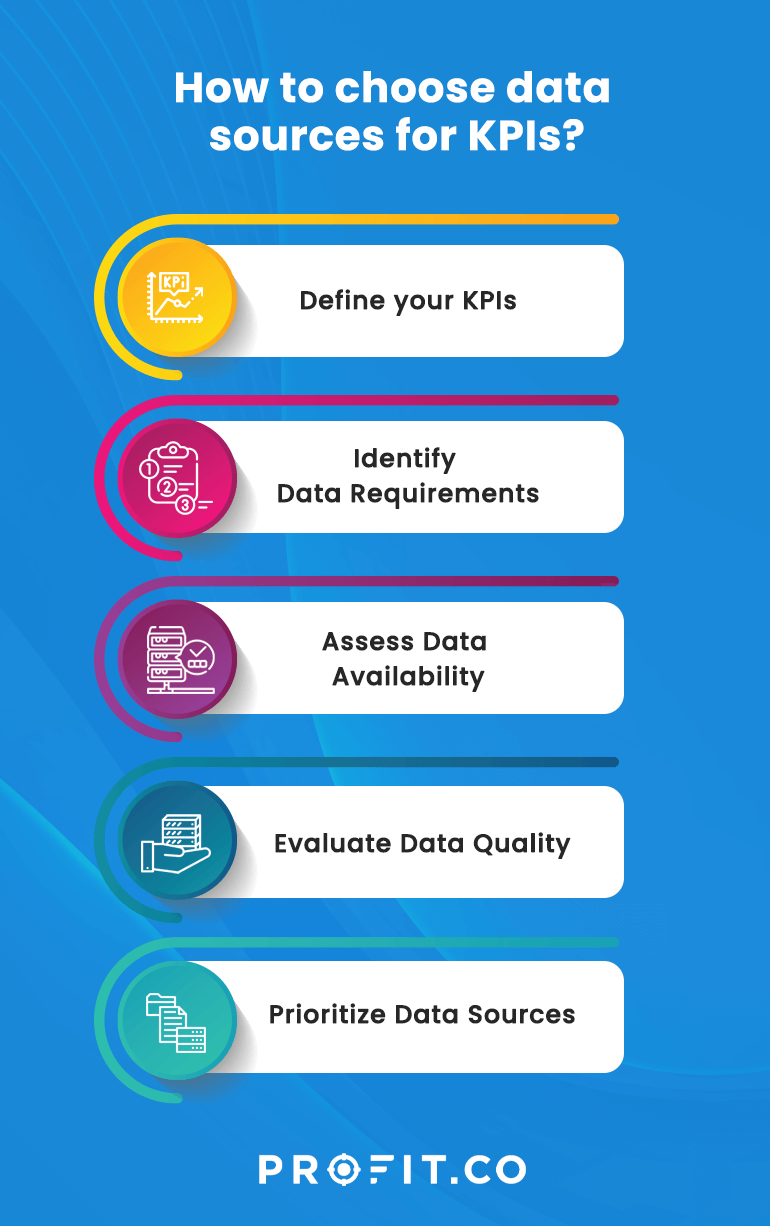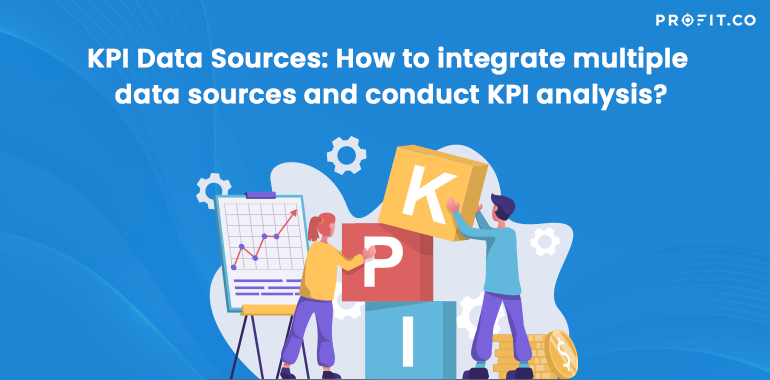With cut-throat competition and increasingly challenging, uncertain business conditions, success heavily depends on informed decision-making. Informed decision-making requires screening vast amounts of relevant data, inferring trends, identifying patterns, and making the right choices based on the findings and insights and KPI reports.
You must obtain and process the right kind of data in a specific way to have business-critical insights. Key Performance Indicators (KPIs) are metrics that combine various data points to provide these invaluable insights into the performance and progress achieved in different aspects of the organization. Tracking and analyzing KPIs helps the management gain decision-making insights, verify strategic alignment, make the right strategic choices, and create a strategic plan that can take the organization on the path to success.
However, the true potential of KPI analysis and the accuracy of the insights obtained depends heavily on the quality and relevance of the underlying data. So choosing the right data points and reliable data sources are crucial, as they determine the accuracy and reliability of KPIs. The reliability of data and KPI accuracy improve further when you select multiple KPI data sources.
In this article, we will explore the KPI data sources and delve into the importance of selecting and combining multiple data points to ensure the relevance and accuracy of KPIs for better strategic planning.
What are KPI data sources?
KPI data sources refer to the systems, platforms, and databases from which relevant data is taken and used to measure and analyze key performance indicators. KPI data sources may include sales records, customer feedback, financial reports, operational databases, etc.
Why does KPI analysis require multiple sources of data?
KPI analysis requires multiple data sources because it provides a comprehensive view of your performance, helps you gain deeper insights, verify progress, and make informed decisions to attain success.
1. Comprehensive Insights:
Multiple KPI data sources provide a more diverse set of perspectives on performance. They further help you cover insights on trends, patterns, and correlations that you otherwise have missed with fewer data sources. When you can feed your KPIs with multiple data streams, you can combine and compare them to ensure their accuracy to get a holistic and comprehensive understanding.
2. Data Validation:
Cross-referencing data from various sources helps validate its accuracy and reliability. When you cross-reference data from multiple sources, you can identify and address discrepancies and inconsistencies among different data sets. It makes data more reliable and information trustworthy, making your KPIs more robust and accurate. As a result, you can confidently derive insights from your KPIs without a shadow of a doubt and subsequently make better strategic decisions.
3. Contextual Understanding:
When you combine different data sources, you can derive unique contextual information. For instance, when you can compare and combine sales data with customer feedback, you can learn more about purchase patterns, customer behavior, and customer satisfaction. It enriches your KPIs, offers more insights, and enables you to make informed strategic decisions and customize your strategies to meet specific objectives.
4. Comprehensive Performance Measurement:
organization’s performance, including financial and operational metrics. These KPIs cannot be treated as isolated measures when analyzing the performance of different operations. They are all connected. For instance, when you spend financial resources on marketing and achieve sales increase and profitability, the financial, sales, and marketing metrics complement each other, and you cannot isolate them. So KPIs related to all these various operations often require data from different sources to comprehend and make sense of the full scope of the performance in these areas.

How to choose data sources for KPIs?
1. Define your KPIs
KPIs must be relevant to your strategy. So when you define your KPIs in your strategic plan, you must ensure their alignment with your strategic objectives and goals.
2. Identify Data Requirements
Data determines the usefulness and accuracy of KPIs. So it is crucial to assess the needs, consider the metrics, dimensions, and granularity needed for accurate measurement and analysis of performance, and identify the specific data requirements for every KPI.
3. Assess Data Availability
While selecting the most suitable data sources can be relatively easy, ensuring the availability of those specific data sets can be a challenge. So you have to evaluate the data availability within your organization and identify potential internal and external sources that can provide you with the required data. You can acquire data from existing systems, research papers, surveys, feedback mechanisms, databases, third-party data providers, etc.
Sometimes, even the KPI data sources within the organization may not provide the data you need, or they may provide inaccurate data. Factors including incomplete or inconsistent data recording, outdated or manual data collection processes, limited integration between systems and analytics platforms, and insufficient data capturing tools or technology may prevent you from getting the data for your KPIs. You have to identify these issues and address them first.
4. Evaluate Data Quality
Once you find your KPI data sources, you must assess their quality, reliability, and accuracy. You must verify the trustworthiness of the data and ensure that it meets the necessary standards for accurate KPI analysis. You can achieve this through:
- Data Profiling, which is the process of analyzing the data characteristics and attributes, such as data types, ranges, and distributions and helps identify inconsistencies, errors, and outliers to ensure data quality.
- Data Validation checks that involve cross-referencing data against known, well-established benchmarks and verifying the completeness, consistency, and integrity of data.
- Data Cleansing that identifies and removes duplicate records, corrects formatting inconsistencies and mistakes, standardizes data, and uses proven methods to fill the missing values; this helps address issues that affect data quality.
- Data Sampling, which is done by randomly selecting a portion of the data and analyzing and comparing it against the source; this helps you identify discrepancies. With periodic data audits to complement data sampling, you can ensure consistency in data quality.
- Implementation of data governance practices, such as assigning responsibilities for monitoring and ensuring data quality, creating data definitions and rules, and implementing data quality improvement initiatives; defining standards, guidelines, and processes streamlines data management.
- User Feedback and Stakeholder Collaboration using surveys, interviews, or focus groups; it helps to understand the perceived quality and usability of the data.
Are you ready to elevate your strategic decision-making?
5.Prioritize Data Sources
The data quality and consistency of data sources may vary. So once you identify the usable KPI data sources, you can prioritize them based on their relevance, accessibility, and quality. Factors that can impact your KPIs may include the completeness of data, timeliness, comprehensiveness, and the magnitude of data needed for effective KPI measurement. For instance, when you need to make quick strategic decisions to adapt to rapidly changing conditions or emerging challenges and threats, you may need real-time data for accurate decision-making. If your data source provides accurate data but suffers from latency, then you may have to either delay your decision-making or make decisions based on outdated data. So you may have to keep that data source on low priority and find a source that provides real-time data.
Integrating multiple data sources and conducting KPI analysis:
Once you select and strategically prioritize your KPI data sources, it is crucial to integrate data from multiple sources for conducting KPI analysis. Combining data enables you to gain a holistic and comprehensive view of performance, derive meaningful insights, identify trends, and make informed decisions to drive strategic goals and optimize business outcomes. Following are the steps involved in integrating data and conducting KPI analysis.
1. Data Integration:
Extract the data from your KPI data sources, convert them to a standardized format, consolidate the data, and feed it into a centralized data storage solution or your analytics system. It enables you to combine the data, cross-check, compare, and analyze all the data together.
2. Data Preparation:
Conduct data cleansing and prepare the data for KPI analysis. Normalize the data into a consistent format and structure to ensure meaningful analysis.
3. KPI Calculation:
Measure the KPIs based on the integrated data. There are unique formulae and algorithms specific to each KPI. Apply them to process the data, derive the desired metrics and measurements, and calculate your KPIs.
4. KPI Analysis
Analyze the calculated KPIs, compare them with benchmarks, estimates, and forecasts, visualize the inferences using charts, dashboards, and infographics, and interpret the findings. Identify the trends, patterns, and anomalies in the data to gain insights into performance and identify areas for improvement.
5. Verify Progress and Tweak the Strategy
Use the KPI analysis to evaluate your progress towards strategic goals and the performance of your strategic initiatives and identify the gaps and areas for improvement. Make data-driven decisions based on these insights to adjust and refine the strategy, ensure its alignment with organizational objectives and maximize the likelihood of success.
FAQs
- What are the data sources for KPI?
Data sources for KPIs refer to the various repositories of data, including systems, platforms, and databases from which relevant data is taken and used to measure and analyze key performance indicators. KPI data sources may include sales records, customer feedback, financial reports, operational databases, etc.
- What is a KPI in a strategic plan?
A Key Performance Indicator (KPI) in a strategic plan is a clearly defined measurable metric for evaluating the progress of your strategy execution and strategic initiatives and the success of your strategic goals. It is specified in the strategic plan as a means to track, measure and quantify performance as the strategy implementation progresses according to the strategic plan. KPIs help you determine if you are achieving your strategic objectives as expected.
- What are KPIs for data analysis?
When you need to measure and track processes and operations to verify their effectiveness, KPIs provide specific metrics for assessing their performance. Examples of KPIs used for data analysis include data quality metrics, data completeness indicators, data accuracy measures, and data usage statistics.
- How do you use KPI data?
Multiple KPI data sources are combined and compared to track KPIs and analyze and interpret the metrics to gain insights into performance. In this process, the measured KPIs are compared against targets, estimates, forecasts, or benchmarks to identify trends or patterns. Based on the findings, you can make informed decisions and take appropriate actions to improve performance.
Conclusion
In the dynamic realm of modern business, harnessing the true potential of Key Performance Indicators (KPIs) hinges on the convergence of diverse data streams. Just as a symphony fuses different instruments into harmonious music, integrating multiple data sources through tools like Profit.co’s KPI dashboard creates a comprehensive and insightful composition that guides strategic refinement, informed decision-making, and success in the face of relentless competition and ever-changing conditions.
